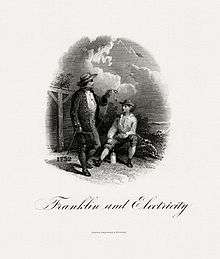Kite experiment
_-_Benjamin_Franklin_Drawing_Electricity_from_the_Sky_-_Google_Art_Project.jpg)
The kite experiment was a scientific experiment which was proposed and may have been conducted by Benjamin Franklin with the assistance of his son William Franklin. The experiment's purpose was to uncover then unknown facts about the nature of lightning and electricity.
Background
In 1750, the electrical nature of lightning was the subject of public discussion in France, with a dissertation of Denis Barbaret receiving a prize in Bordeaux; Barbaret proposed a cause in line with the triboelectric effect. The physicist Jacques de Romas also wrote a memoir that year with similar ideas. Franklin had listed a dozen analogies between lightning and electricity in his notebooks at the end of 1749.[1] Speculations of Jean-Antoine Nollet had led the issue being posed as a prize question at Bordeaux in 1749. De Romas later defended his own electrical kite proposal as independent of Franklin's.[2]
Lightning rod experiments
In 1752, Franklin proposed an experiment with conductive rods to attract lightning to a Leyden jar, an early form of capacitor. Such an experiment was carried out in May 1752 at Marly-la-Ville in northern France by Thomas-François Dalibard.[3] An attempt to replicate the experiment killed Georg Wilhelm Richmann in Saint Petersburg in August 1753; he was thought to be the victim of ball lightning.[4] Franklin himself is said to have conducted the experiment in June 1752, supposedly on the top of the spire on Christ Church in Philadelphia. However, doubts have been expressed about whether the experiment was actually performed (see below).
Franklin realized the dangers of using conductive rods and instead used his son to fly the kite. This allowed him to stay on the ground and the kite was less likely to electrocute him. According to the legend, Franklin kept the string of the kite dry at his sons's end to insulate him while he was allowed to get wet in the rain to provide conductivity. A house key belonging to Benjamin Loxley was attached to the string and connected to a Leyden jar, which Franklin assumed would accumulate electricity from the lightning. The kite was not struck by visible lightning; had it done so, Franklin would almost certainly have been killed. However, Franklin did notice that the strings of the kite were repelling each other and deduced that the Leyden jar was being charged. He moved his hand near the key afterwards, because as he had estimated, lightning had negatively charged the key and the Leyden jar, proving the electric nature of lightning.[5]
De Romas pursued his priority claim to the kite experiment. He had it recognised by the Bordeaux Academy, and then the Académie française in Paris.[3]
Modern controversy
The standard account of Franklin's experiment was disputed following an investigation and experiments based on contemporaneous records by science historian Tom Tucker, the results of which were published in 2003.[6] According to Tucker, Franklin never performed the experiment, and the kite as described is incapable of performing its alleged role.[7]
Further doubt about the standard account has been cast by an investigation by the television series MythBusters. The team found evidence that Franklin would have received a fatal current through his heart had the event actually occurred. Nevertheless, they confirmed that certain aspects of the experiment were feasible - specifically, the ability of a kite with sufficiently damp string to receive and send to the ground the electrical energy delivered by a lightning strike.[8]
Because of the danger inherent in the kite experiment, it has become illegal in certain locales.[9]
References
- ↑ Pierre Zweiacker (24 November 2011). Sacrée foudre !: Ou la scandaleuse invention de Benjamin F. (in French). Presses polytechniques et universitaires romandes. p. 165. ISBN 978-2-88074-943-9. Retrieved 29 October 2012.
- ↑ J. L. Heilbron (1979). Electricity in the 17th and 18th Centuries: A Study of Early Modern Physics. University of California Press. p. 351 note 32. ISBN 978-0-520-03478-5. Retrieved 29 October 2012.
- 1 2 Jessica Riskin (15 December 2002). Science in the Age of Sensibility: The Sentimental Empiricists of the French Enlightenment. University of Chicago Press. p. 101. ISBN 978-0-226-72078-4. Retrieved 29 October 2012.
- ↑ Vladimir A. Rakov; Martin A. Uman (8 January 2007). Lightning: Physics and Effects. Cambridge University Press. p. 656. ISBN 978-0-521-03541-5. Retrieved 29 October 2012.
- ↑ An article about Franklin and the experiment
- ↑ Bolt of Fate by Tom Tucker Public Affairs books 2003
- ↑ Benjamin Franklin "faked kite experiment" Sunday Telegraph 1 June 2003
- ↑ "Franklin Discovered Electricity with Kite". Mythbusters. 11 April 2012. Retrieved 2016-07-30.
- ↑ "St. Louis, Missouri, Code of Ordinances: Chapter 15.155 - KITES". Retrieved 28 September 2013.
External links
- Philosophical Transactions: A Letter of Benjamin Franklin, Esq; to Mr. Peter Collinson, F. R. S. concerning an Electrical Kite. Phil. Trans. 1751–1752 47, 565–567; (PDF)
- http://www.pbs.org/benfranklin/shocking/
